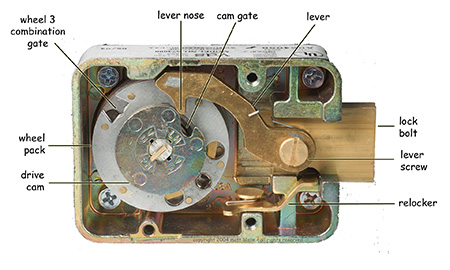
 When I published Safecracking for the Computer Scientist [pdf] a few years ago,
I worried that I might be alone in harboring
a serious interest in the cryptologic aspects of physical security.
Yesterday I was delighted to discover that I had been wrong. It turns out that more than
ten years before I wrote up my safecracking survey, a detailed
analysis of the keyspaces of mechanical safe locks had already been
written, suggesting a simple and practical dictionary attack of which I was completely
unaware. But I have an excuse for my ignorance: the study was published
in secret, in Cryptologic Quarterly, a classified technical
journal of the US National Security Agency.
When I published Safecracking for the Computer Scientist [pdf] a few years ago,
I worried that I might be alone in harboring
a serious interest in the cryptologic aspects of physical security.
Yesterday I was delighted to discover that I had been wrong. It turns out that more than
ten years before I wrote up my safecracking survey, a detailed
analysis of the keyspaces of mechanical safe locks had already been
written, suggesting a simple and practical dictionary attack of which I was completely
unaware. But I have an excuse for my ignorance: the study was published
in secret, in Cryptologic Quarterly, a classified technical
journal of the US National Security Agency.
This month the NSA quietly declassified a number of internal technical and historical documents from the 1980's and 1990's (this latest batch includes more recent material than the previously-released 1970's papers I mentioned in last weekend's post here). Among the newly-released papers was Telephone Codes and Safe Combinations: A Deadly Duo [pdf] from Spring 1993, with the author names and more than half of the content still classified and redacted.
Reading between the redacted sections, it's not too hard to piece together the main ideas of the paper. First, they observe, as I had, that while a typical three wheel safe lock appears to allow 1,000,000 different combinations, mechanical imperfections coupled with narrow rules for selecting "good" combinations makes the effective usable keyspace smaller than this by more than an order of magnitude. They put the number at 38,720 for the locks used by the government (this is within the range of 22,330 to 111,139 that I estimated in my Safecracking paper).
38,720 is a lot less than 1,000,000, but it probably still leaves safes outside the reach of manual exhaustive search. However, as the anonymous* [see note below] NSA authors point out, an attacker may be able to do considerably better than this by exploiting the mnemonic devices users sometimes employ when selecting combinations. Random numeric combinations are hard to remember. So user-selected combinations are often less than completely random. In particular (or at least I infer from the title and some speculation about the redacted sections), many safe users take advantage of the standard telephone keypad encoding (e.g., A, B, and C encode to "2", and so on) to derive their numeric combinations from (more easily remembered) six letter words. The word "SECRET" would thus correspond to a combination of 73-27-38.
This "clever" key selection scheme, of course, greatly aids the attacker, reducing the keyspace of probable combinations (after "bad" combinations are removed) to only a few hundred, even when a large dictionary is used. The paper further pruned the keyspaces for targets of varying vocabularies, proposing a "stooge" list of 176 common words, a "dimwit" list of 166 slightly less common words, and a "savant" list of 244 more esoteric words. It would take less than two hours to try all of these combinations by hand, and less than two minutes with the aid of a mechanical autodialer; on average, we'd expect to succeed in half that time.
Dictionary attacks aren't new, of course, but I've never heard of them being applied to safes before (outside of the folk wisdom to "try birthdays", etc). Certainly the net result is impressive -- the technique is much more efficient than exhaustive search, and it works even against "manipulation resistant" locks. Particularly notable is how two only moderately misguided ideas -- the use of words as key material plus overly restrictive (and yet widely followed) rules for selecting "good" combinations -- combine to create a single terrible idea that cedes enormous advantage to the attacker.
Although the paper is heavily censored, I was able to reconstruct most of the missing details without much difficulty. In particular, I spent an hour with an online dictionary and some simple scripts to create a list of 1757 likely six-digit word-based combinations, which is available at www.mattblaze.org/papers/cc-5.txt . (Addendum: A shorter list of 518 combinations based on the more restrictive combination selection guidelines apparently used by NSA can be found at www.mattblaze.org/papers/cc-15.txt ). If you have a safe, you might want to check to see if your combination is listed.
As gratifying as it was to discover kindred sprits in the classified world, I found the recently released papers especially interesting for what they reveal about the NSA's research culture. The papers reflect curiosity and intellect not just within the relatively narrow crafts of cryptology and SIGINT, but across the broader context in which they operate. There's a wry humor throughout many of the documents, much like what I remember pervading the old Bell Labs (the authors of the safe paper, for example, propose that they be given a cash award for efficiency gains arising from their discovery of an optimal safe combination (52-22-37), which they suggest everyone in the government adopt).
It must be a fun place to work.
Addendum (7-May-2008): Several people asked what makes the combinations proposed in the appendix of the NSA paper "optimal". The paper identifies 46-16-31 as the legal combination with the shortest total dialing distance, requiring moving the dial a total of 376 graduations. (Their calculation starts after the entry of the first number and includes returning the dial to zero for opening.) However, this appears to assume an unusual requirement that individual numbers be at least fifteen graduations apart from one another, which is more restrictive than the five (or sometimes ten) graduation minimum recommended by lock vendors. Apparently the official (but redacted) NSA rules for safe combinations are more restrictive than mechanically necessary. If so, the NSA has been using safe combinations selected from a much smaller than needed keyspace. In any case, under the NSA rule the fastest legal word-based combination indeed seems to be 52-22-37, which is derived from the word "JABBER", although the word itself was, inexplicably, redacted from the released paper. However, I found an even faster word-based combination that's legal under more conventional rules: 37-22-27, derived from the word "FRACAS". It requires a total dial movement of only 347 graduations.
* Well, somewhat anonymous. Although the authors' names are redacted in the released document, the paper's position in a previously released and partially redacted alphabetical index [pdf] suggests that one of their names lies between Campaigne and Farley and the other's between Vanderpool and Wiley.